Today, with the advance in mobile technology, virtual reality, and augmented reality, a student’s learning experience is not only limited to learning inside the classroom, but complemented, enhanced, or even amplified by these technologies which could be utilized outside the classroom. These technologies are helping to set the trend of gamification of learning, which is the application of gaming mechanics, such as scoring or competitions, to engage and motivate students to learn. Schools and institutions in Asia are actively exploring the use of these technologies for gamification of learning to complement traditional lecture-style teaching and learning. In this article, we shall look at specific details of these efforts and examine how these technology can be applied in such a way that students can experience a highly engaged learning process.
Learning Anytime, Anywhere with Mobile Technology
With mobile devices becoming more and more powerful and affordable, the possibilities of educational apps designed for mobile devices dramatically increases. As a result, learning is becoming more and more ubiquitous, as device portability enables students to learn anytime and anywhere. An example of such mobile learning development is the suite of learning apps developed by the Resource Centre for Ubiquitous Learning and Integrated Pedagogy (ULIP) at Hong Kong Baptist University designed to address the issue of language learning.
English vocabulary learning has always been a barrier for Hong Kong Chinese students whose native language is not English. Although they have been learning English since primary school, students often lack conversational experience in the language, resulting in a limited vocabulary. To help counter this problem, the use of crossword puzzles can be an ideal solution, as they are typically considered an entertaining game rather than tedious and boring classwork, and tend to be enjoyable and learner-friendly. In addition to motivating learning, students gain greater retention and memorization of vocabulary since they have to spell items correctly in order to complete the crossword puzzle. In light of this, ULIP has developed a crossword puzzle game mobile app (see Figure 1), which contains vocabularies used in a first-year English language course at HKBU, and is currently being deployed to over one thousand Hong Kong Chinese students, typically aged between 17-19 years old. The vocabularies in the crossword puzzle game app are selected to appear in the course’s examination, so the app is actually part of the student’s exam revision material. A survey was distributed to gauge students’ view of the app, and revealed that the app is positively received in general, and students find it useful for learning and memorizing English vocabularies.
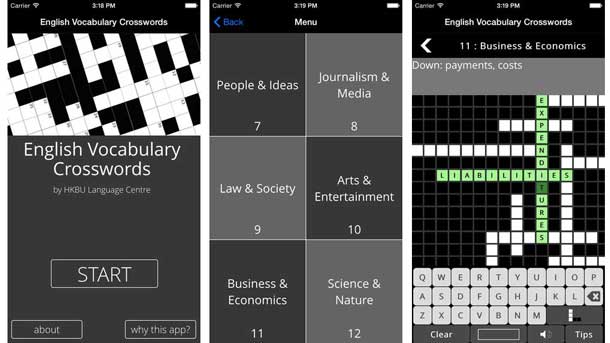
Another app, the Interactive Phonetics – An Audio-Visual IPA Reference (see Figure 2) not only acts as a mobile study guide with interactive features such as a clickable IPA (Interactional Phonetic Alphabet) audio chart, but also contains a mini-game that aims to help students drill phonetic alphabets and their pronunciation.
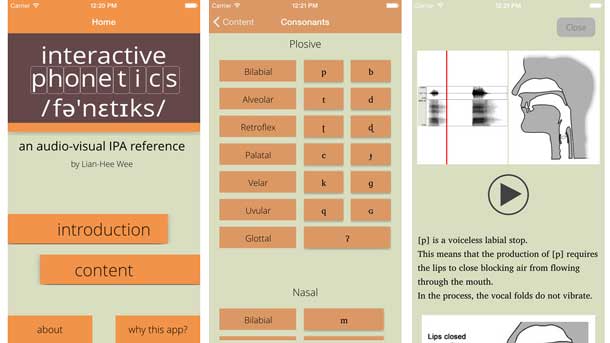
In the game, a sequence of phonetic alphabets fall down the playing field while an audio pronunciation is being playback simultaneously. Students have to tap on the falling letters that match the pronunciation. Gold coins and medals are awarded (see Figure 3) for correctly tapped phonetic letters, and hearts (or lives) are deducted for incorrect answers. Penalties, coupled with rewards and achievements, are important elements of an engaging learning experience, in this case, the drilling of audio and visual recognition of phonetic alphabets on a repetitive basis.
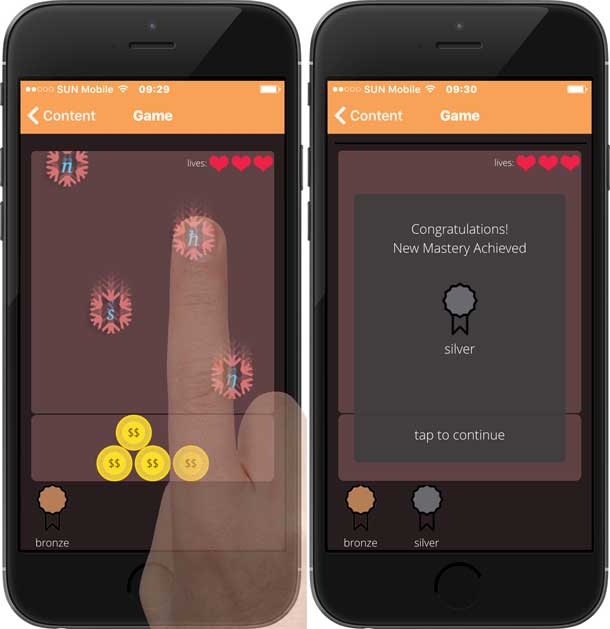
From a user experience perspective, these mobile learning apps are ideal for university students living in densely populated Asian cities such as Hong Kong, as they are more likely to commute on public transport (rather than driving to and from schools) than their counterparts in Europe or America. These mobile games can be a great way to help students drill on English vocabulary or phonetic pronunciation during mundane bus or train rides.
Bloom’s taxonomy, first devised in 1956 by educational psychologist Benjamin Samuel Bloom, has widely been used as a framework for many modern teaching philosophies and methodologies. It helps instructional designers clearly define observable intended learning outcomes for their teaching material design. All learning outcomes are described by verbs that are categorized into different levels in the cognitive domain (see Figure 4). On the cognitive front, the games in the crossword puzzle and phonetic learning apps are effective in training students on memorization and recall of knowledge. In Bloom’s taxonomy, these games address the most basic level of learning (bottom of the pyramid).
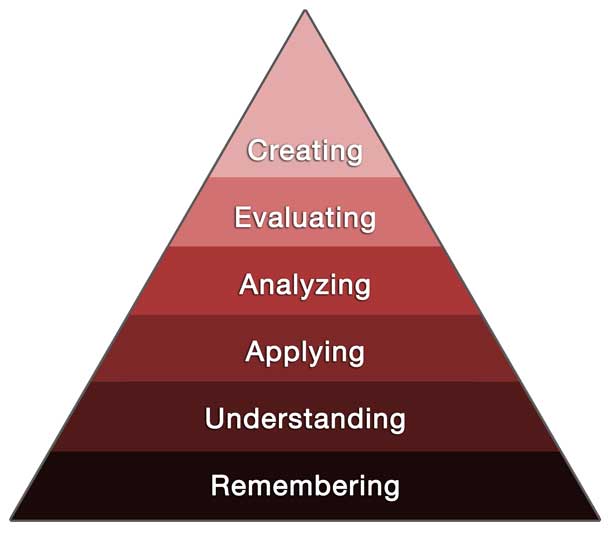
Augmented Reality for Learning
Another innovative example of mobile learning is the concept of the augmented reality learning trail developed in Singapore. A series of mobile learning contents such as historical facts and videos are designed to overlay on top of the real world environment at numerous historical sites in the Singapore downtown area (see Figure 5). This is made possible by a combined application of camera image recognition, GPS, and Bluetooth sensors to detect a user’s physical location and retrieve location-specific learning contents via a learning trail mobile app. For instance, when students physically arrive at the Raffle’s Landing Site in downtown Singapore, the app detects the students’ location thru GPS, and retrieves multimedia contents that describe the landing of Sir Thomas Stamford Bingley Raffles at that physical location in the 19th century, and related information on his founding of Singapore. Questions and learning activities related to this historical figure and event are also presented to the students through the app.
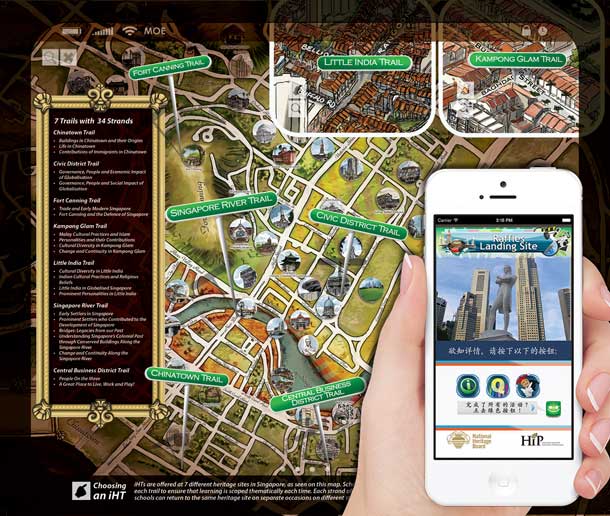
Unlike the language learning apps previously described, this learning trail app contains learning activities that allow students to integrate and synthesize knowledge in the context of the real-world environment. When students are asked to take photos of real-world objects or write a brief paragraph to describe a historical event that took place at their present location, they are cognitively exposed to higher levels of learning (in Bloom’s taxonomy: understanding, applying, and analyzing). In fact, as many as 45% of Singaporean secondary school students who participated in the learning trails reported that the learning activities enabled them to connect with the past by helping them visualize what happened at a particular place in history.
To date, more than a hundred Primary and Secondary schools in Singapore—involving a total of 120,000 students—have participated in the interactive learning trails, and 95% of the participating schools expressed a preference for mobile over a pen/paper or tour guide solution. Why is this such an attractive tool for the schools?
Augmented Reality and Mobile Learning: Win-Win for Students and Teachers
Learning in a real-world environment is traditionally done through field trips in which both the teaching and learning are tied to a specific time and location. But with mobile technology, the learning experience is more flexible and personalized; students can now learn at their own pace and at their own time. With augmented reality, students are more engaged when learning in the real-world environment, especially for subjects like history and geography, as knowledge is contextually relevant information presented in a multimedia format. Research published in The New Media Consortium’s 2011 Horizon Report suggested that contextual learning in the real-world environment can lead to learning that is better embedded. Instructors can be freed from the hassles of organizing a field trip and spend more time and resources in-class (such as debriefing sessions) to help students synthesize knowledge acquired from the real-world environment. In short, learning through augmented reality enhances both the teaching experience of the instructor, as well as the learning experience of the students.
Virtual Reality and Online Games: A New Form of Collaborative Learning
Virtual Reality (VR) is also being utilized for learning in different areas. For instance, Second Life, a virtual world environment in which instructors can easily build anything from a virtual classroom to a full-scale chemistry laboratory, can be used for trainings such as lab safety or even the demonstration of chemistry experiments. VR also finds its way into military training, where soldiers are immersed in simulated battlefield environments—like those found in popular first-person shooter computer games such as Call of Duty and Battlefield—to learn and exercise combat strategies. It is therefore evident that learning can occur in a casual gaming environment created by VR.
The advances in networking technologies have led to a rapid growth in VR of which Massively Multiplayer Online Games (MMOGs) is one of the popular genres. Most of the time, MMOG play is assumed to be a negative phenomenon which contributes to poor adjustment to college environment, depression, and interpersonal problems. Despite the skepticism about the benefits of MMOG play, some industrial reports (for example, Gaming and Leadership Report: Virtual World’s Real Leaders by IBM) have suggested that online gaming activity could also exert positive effects on players. In that sense, we believe that Massively Multiplayer Online Role Play Games (MMORPGs), one type of MMOG, foreshadows new possibilities for effective leadership development.
World of Warcraft (WoW), Everquest, and Diablo are examples of popular MMORPGs with millions of subscribers globally. These online games include characters with interesting leadership roles, such as raid and guild leaders. When the role-playing gamers team up to undertake a quest (see Figure 6), they are often required to solve difficult tasks until they find the necessary actions and techniques that allow them to succeed and proceed. On the cognitive front, the games are effective in training students on three areas of learning at different cognitive levels according to Bloom’s Taxonomy.
- Understanding the social rules and structure
- Applying leadership skills to manage the collaboration among teams
- Analyze and evaluate strategies so as to achieve the desired outcomes
Indeed, the fact that collaboration is needed with other players so as to advance their avatars represents a strong motivator for players to learn to become a leader, as a single player cannot accomplish the tasks alone.
Although MMORPGs focus on collaborative casual gaming, the activities in which they are engaged are very similar to the attributes of real-life teamwork. Leadership training could be done at high cognitive level in reference to the Bloom’s taxonomy.
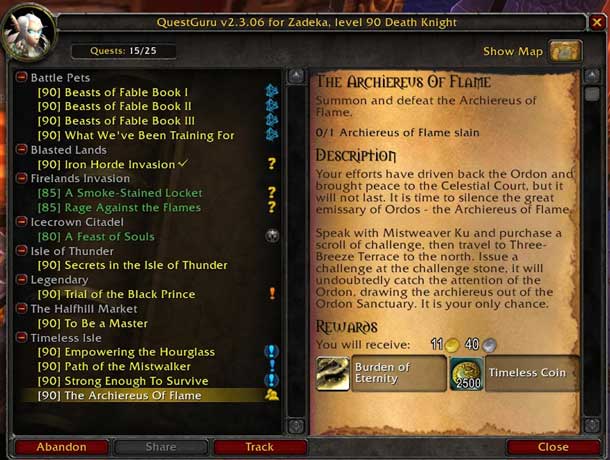
The Importance of Social Interaction for Learning with VR
Dr. Dimple Thadani (one of the authors) conducted a survey of 97 current MMORPG players in Asia. The results have suggested that the motivation of the players is linked to different styles of leadership: transactional and transformational leadership. Transactional leadership is a style of leadership in which leaders promote compliance of the followers through both reward and punishment. Thus the leader-follower relationship is based mainly on contracts. On the contrary, transformational leadership is a style of leadership in which leaders focus on team-building and collaboration. The leaders focus on inspiring the followers. The results of the study suggested that extrinsic motivation (for example, tangible rewards) is strongly related to transactional leadership style, whereas intrinsic motivation (for instance, interest or happiness) is related to transformational leadership style. This finding suggests that VR game design should introduce more social features to maintain users’ interest and happiness rather than solely on in-game tangible rewards. In this way, trainees can learn both styles of leadership and develop their own pace and style.
User Experience in VR
To evaluate if MMORPG could become a suitable medium for teaching and learning in the future, we conducted another study to explore the role of user experience in determining the users’ continuance intention (intention to use the system, or in this case, to play the MMORPG on a continuous basis). An online survey was distributed to members of a nationwide panel of Chinese online gamers. The survey results reveal that user satisfaction and enjoyment are two critical factors in determining users’ continuance intention in MMORPG. This finding suggests that VR game design should maintain or elevate the emotion of players rather than focusing solely on cognitive benefits such as in-game rewards and achievements. Thus, educational designers who are considering the use of VR for teaching and learning should embed narratives in which students could easily become immersed and be engaged in a game-like environment. In addition, implementation of leaderboards, which is typically found in online games for engaging players, could inform students of their progress so as to create a sense of satisfaction in their learning experience.
Engaged Learning
So far, we have seen how mobile technology, augmented reality, and virtual reality can be utilized for gamification of learning. The key to their success is engagement; engaged students are more likely to learn better, just as engaged users on an ecommerce site are more likely to become customers.
In summary, we have looked at several examples and techniques to engage students thru gamification of learning:
- When appropriate, use game-based mobile apps as part of the course material so students can play, learn, and review contents anytime, anywhere.
- For simple repetitive exercises, use rewards and penalties (even if it is only virtual ones) to encourage continuous usage.
- For learning using augmented reality, use contextually relevant mobile contents.
- For learning in virtual reality, use narratives coupled with social and competitive elements, to emotionally immerse students into the learning experience.
Looking Ahead: Quantifying the Learner Experience
There are well-established metrics for quantifying the usability of a user-interface (such as success rate and time-on-task) that can inform businesses on the user experience design of a website or software application. However, there is no such metric that could inform educational designers on the learner experience design of a game-based learning tool. While the effectiveness of an ecommerce site can be measured by sales figures, the effectiveness of a learning tool should be measured by whether students can achieve well-defined learning outcomes after using the learning tool.
How does student engagement with a game-based learning tool relate to their achievement of intended learning outcomes? For instance, is there an optimal amount of time a student could spend per day on a crossword puzzle app to memorize a fixed set of English vocabularies? Or could there be an optimal number of times in which a student should perform team-based virtual tasks in MMORPGs that can lead to acquisition of certain leadership skills? As gamification of learning continues to develop, it is hoped that such learner experience metrics can be researched and developed, so that educational designers can measure the effectiveness of the game-based learning experience and make informed decisions on their pedagogical design.
